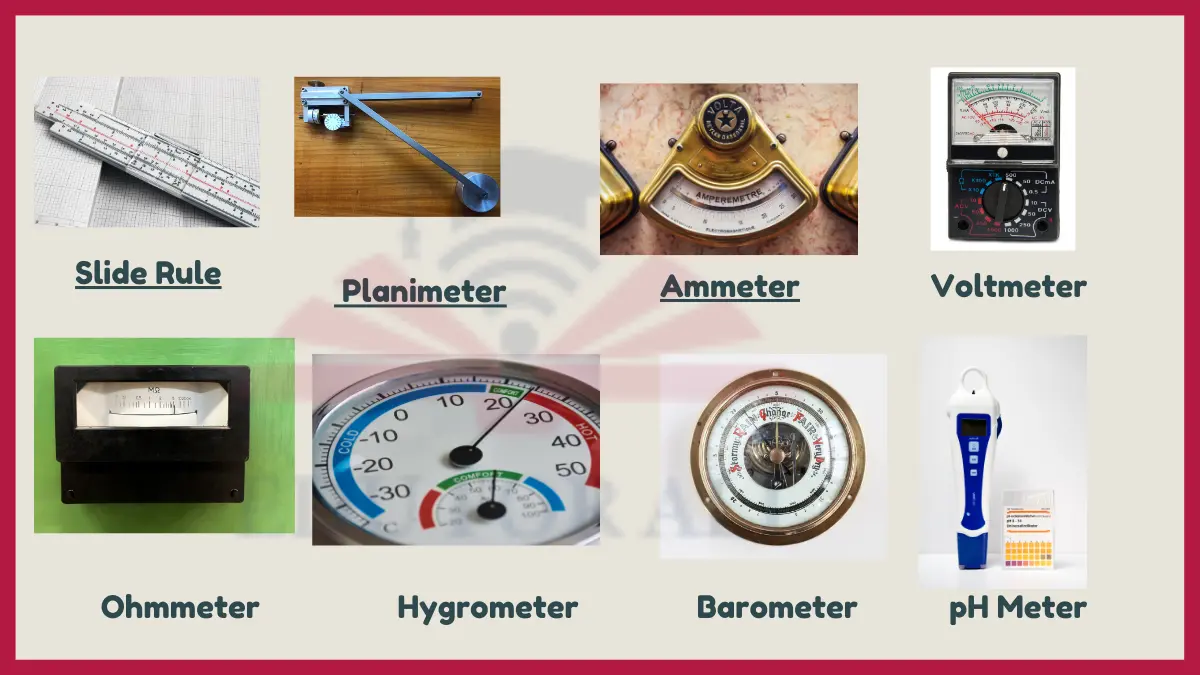Slide Rule, voltmeter, ammeter, planimeter, Ohm meter, hygrometer, Barometer, and pH meter are some most common examples of analog computers.

- Examples of Analog Computers
- 1. Slide Rule
- 2. Planimeter
- 3. Nomogram
- 4. Antikythera Mechanism
- 5. Torquetum
- 6. Astrolabe
- 7. Analog Clock
- 8. Gyroscope
- 9. Voltmeter
- 10. Ammeter
- 11. Ohmmeter
- 12. Hygrometer
- 13. Barometer
- 14. Altimeter
- 15. Thermometer
- 16. Psychrometer
- 17. pH Meter
- 18. FN Tube Integrator
- 19. Bush Differential Analyzer
- 20. Water Tank Integrator
- 21. Kelvin Tide Predictor
- 22. Light Beam Oscilloscope
- 23. Vibrating Reed Electrometer
- 24. Abacus
Examples of Analog Computers
Here are a few Examples of Analog Computers:
1. Slide Rule
The slide rule was invented in the 17th century and was widely used by engineers and scientists until the advent of digital calculators.
The slide rule is used to perform mathematical calculations such as multiplication, division, trigonometry, and exponents.
2. Planimeter
The planimeter was invented in the 19th century and was used by surveyors and cartographers to measure the areas of irregular shapes on maps.
The planimeter is used to measure the area of irregular shapes by tracing over the shape with a pointer. The area is then calculated based on the distance traveled by the pointer and the scale of the map.
3. Nomogram
The nomogram was invented in the 19th century and was used by engineers and scientists to solve complex equations quickly and easily.
The nomogram is a graphical calculator that allows users to solve equations by aligning values on scales. The solution to the equation can then be read from another scale.
4. Antikythera Mechanism
The Antikythera mechanism is an ancient Greek astronomical calculator that was used to predict astronomical events such as eclipses. It was built in the 2nd century BC and is considered to be the first known analog computer.
The Antikythera mechanism was used to predict astronomical events such as eclipses, equinoxes, and solstices. It was also used to track the movements of the planets.
5. Torquetum
The torque-tum was invented in the 15th century and was used by astronomers and navigators to measure the positions of celestial bodies.
The torque-tum is used to measure the positions of celestial bodies by sighting them through two tubes that are mounted on a rotating disk. The disk is calibrated with scales that allow the user to measure the altitude and azimuth of the celestial body.
6. Astrolabe
The astrolabe was invented in the 1st century AD and was used by astronomers and navigators to identify stars and planets, tell time at night, and determine latitude.
The astrolabe is a navigational and astronomical instrument that is used to measure the positions of celestial bodies. It is also used to tell time and determine latitude.
7. Analog Clock
The analog clock was invented in the 13th century and is still widely used today to display time.
The analog clock is used to display the time by positioning hour and minute hands according to the continuous rotation of gears connected to an oscillator.
8. Gyroscope
The gyroscope was invented in the 19th century and is still widely used today in navigation, aircraft stabilization, and robotics.
The gyroscope is used to sense orientation and angular velocity. It does this by using a spinning disk to maintain a fixed orientation in space.
9. Voltmeter
The voltmeter was invented in the 19th century and is still widely used today by electricians and electronics technicians.
The voltmeter is used to measure voltage in electrical circuits. It does this by converting the voltage into a deflection of a pointer on a scale.
10. Ammeter
The ammeter was invented in the 19th century and is still widely used today by electricians and electronics technicians.
The ammeter is used to measure current in electrical circuits. It does this by converting the current into a deflection of a pointer on a scale.
11. Ohmmeter
The ohmmeter was invented in the 19th century and is still widely used today by electricians and electronics technicians.
The ohmmeter is used to measure resistance in electrical circuits. It does this by converting the resistance into a deflection of a pointer on a scale.
12. Hygrometer
The hygrometer was invented in the 18th century and is still widely used today in meteorology and other sciences to measure humidity.
The hygrometer is used to measure the amount of water vapor in the air. It does this by converting the humidity into a deflection of a pointer on a scale or by changing the electrical conductivity of air.
13. Barometer
The barometer was invented in the 17th century and is still widely used today in meteorology and other sciences to measure atmospheric pressure.
The barometer is used to measure the weight of the air. It does this by converting the atmospheric pressure into a deflection of a pointer on a scale.
14. Altimeter
The altimeter was invented in the early 20th century and is still widely used today in aircraft to measure altitude.
The altimeter is used to measure the height of an aircraft above sea level. It does this by converting the atmospheric pressure into a measurement of altitude.
15. Thermometer
The thermometer was invented in the 17th century and is still widely used today to measure temperature.
The thermometer is used to measure the temperature of a substance. It does this by converting the temperature into a deflection of a pointer on a scale or by changing the electrical conductivity of a material.
16. Psychrometer
The psychrometer was invented in the 19th century and is still widely used today in meteorology and other sciences to measure relative humidity.
The psychrometer is used to measure the amount of water vapor in the air relative to the amount of water vapor that the air could hold at a given temperature. It does this by measuring the wet-bulb and dry-bulb temperatures of the air.
17. pH Meter
The pH meter was invented in the early 20th century and is still widely used today in chemistry and other sciences to measure the pH of solutions.
The pH meter is used to measure the acidity or alkalinity of a solution. It does this by converting the pH into a deflection of a pointer on a scale or by changing the electrical conductivity of a material.
18. FN Tube Integrator
The FN tube integrator was invented in the 1940s and was used in analog computers to perform analog computations of integrals and derivatives.
The FN tube integrator was used to perform analog computation of integrals and derivatives. It did this by using a vacuum tube to convert the input signal into a voltage that was proportional to the integral of the input signal.
19. Bush Differential Analyzer
The Bush differential analyzer was invented in the 1930s and was used in analog computers to mechanically integrate differential equations.
The Bush differential analyzer was used to mechanically integrate differential equations. It did this by using a set of gears and pulleys to convert the differential equation into a mechanical system.
20. Water Tank Integrator
The water tank integrator was invented in the 1940s and was used in analog computers to perform analog computing by using hydraulic analogies to solve differential equations.
The water tank integrator was used to perform analog computing by using hydraulic analogies to solve differential equations. It did this by using a tank of water to represent the differential equation.
21. Kelvin Tide Predictor
The Kelvin tide predictor was invented in the late 19th century and was used to calculate tide heights at a port by summing harmonic tidal components mechanically using pulleys and gears.
The Kelvin tide predictor was used to calculate tide heights at a port by summing harmonic tidal components mechanically using pulleys and gears.
22. Light Beam Oscilloscope
The light beam oscilloscope was invented in the early 20th century and is still widely used today to display waveform signals.
The light beam oscilloscope is used to display waveform signals by deflecting an electron beam across a phosphor screen, with the beam motion analogous to the signal.
23. Vibrating Reed Electrometer
The vibrating reed electrometer was invented in the 19th century and was used to measure analog electric signals using the mechanical resonance frequencies of vibrating reeds induced by the voltages.
The vibrating reed electrometer was used to measure analog electric signals using the mechanical resonance frequencies of vibrating reeds induced by the voltages.
24. Abacus
The abacus is an ancient calculating device that is still used today in some parts of the world.
The abacus is used to perform mathematical calculations by manipulating beads on rods as analog representations of decimal place values.

